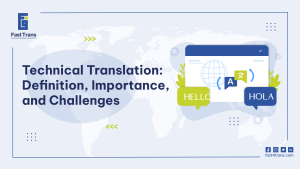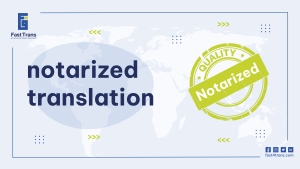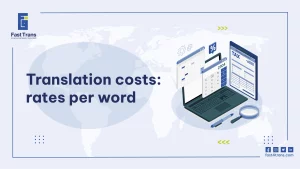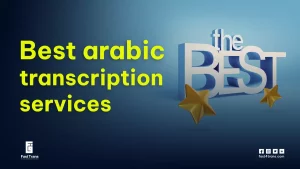Arabic Transcreation goes beyond translation, focusing on creatively adapting content to resonate with the target audience while maintaining emotional impact, tone, and cultural relevance—often used in marketing and advertising. It involves altering cultural references and idiomatic expressions, making it a more flexible process. In contrast, Arabic Translation is about faithfully conveying the original message, ensuring accuracy and clarity, especially for technical or legal documents. While both require linguistic expertise, transcreation demands more creativity and adaptation to different mediums, whereas translation maintains fidelity to the source text.
Know more about Arabic Transcreation vs. Arabic Translation in this article.
What is Arabic transcreation?
Arabic Transcreation is the combination of the word translation” and “creation”. This implies that it goes beyond the Arabic translation of source text meaning into the target one. It is a creative process that involves adapting content from one language to Arabic while maintaining its meaning, context, emotional impact, intent, tone, and context. In short, it’s the closer it can get to multilingual copywriting.
Unlike Arabic translation, which focuses on fidelity, Arabic transcreation prioritizes resonance with the target audience. It may involve altering cultural references, idiomatic expressions, and even the overall message to evoke the desired response from the audience
Read more: What is transcreation?
What is Arabic translation?
On the other hand, Arabic translation is the art of rendering text or speech from one language into Arabic while preserving the original meaning, tone, and intent as faithfully as possible. It has a long history of several evolving approaches and techniques. Generally. Arabic translation involves a meticulous process of linguistic analysis, cultural understanding, and linguistic fidelity. The primary goal of Arabic translation is accuracy and clarity, ensuring that the message is conveyed effectively to the target audience without losing its essence. Moreover, it’s still a highly creative act that in many instances can be as creative as Arabic transcreation.
Read more: What is translation?
Arabic Transcreation vs. Arabic Translation
The main difference is levels of creativity: translation, as you might know by now, is about replacing words from source to target language to accurately give the same meaning; transcreation is not loyal to the source text as much as it aims at conveying concepts, emotions, or messages across languages and cultures.
Let’s dwell more on this below:
1. Arabic Transcreation originated in the literary field
Although today we use the term Arabic transcreation in the advertising sphere, its start was literary, specifically among literary academicians. The first time the term was used was in 1957 by an Indian scholar to refer to works of drama. Almost a decade later, the term was revisited by other literary figures like H. de Campos who used it to describe a new approach to literary Arabic translation.
While Arabic transcreation is relatively new, translation dates back ages and centuries ago. You can think of the Rosetta Stone, discovered in 1799, the Epic of Galgamis, and Bible translation as early examples. It started as a luxury, primarily to spread religion. After the Industrial Revolution, print became universally available, it set off the world to its present globalized state.
2. Arabic Transcreation is crucial to content
The main difference between these two terms in the business world is their usage. For instance, Arabic transcreation is related to the content produced every day by the staff writers and social media team. It depends on the cultural understanding of the target audience, with some advertising background. It can impact everything from content’s emotional and cultural impact, to consumer engagement and behavior, and brand perception.
While Arabic translation focuses on fidelity to the original text. In the business industry, the goal of Arabic translation is to accurately convey the original message from one language to Arabic, ensuring that technical details, legal terms, and factual information remain consistent and precise. This is crucial for documents such as contracts, user manuals, and financial reports, where accuracy and clarity are paramount.
3. Arabic Transcreators are both writers and linguists
Arabic Transcreators are usually writers. They create copies for businesses. However, sometimes a copywriter can translate. The process also involves UX designers.
However, Arabic translators are essentially linguistic experts who have a professional command of their language pair. Although some of the best translators out there are also amazing writers.
4. Every Transcreation starts with a creative brief
Since both Arabic translation and Arabic transcreation are different processes, they also start off differently. For example, a translation task usually starts with the source text as the main and most important reference. A translator might be aided by a glossary or a style guide. But, transcreation starts with a creative brief.
The creative brief provides transcreators with all the relevant information like topic idea, objective, target audience, links to websites, competitors, previous successful advertising campaigns, and everything in between.
5. Transcreation deals with non-textual aspects
Transcreation applies to creative circumstances, specifically to copy intended to trigger a particular emotion or action. This includes reworking brand names and slogans as well as visual aspects: layout, formatting, typography, images, emojis, and colors. Transcreation providers may offer advice on how content looks, feels, and would resonate with the target audience. This is because, transcreators work with several mediums like websites, applications, product packaging, social media advertising, and others of the like where the visual aspect is a huge player.
Conversely, There is a range of translation types, but the work of translation is mostly limited to the text (words, characters, numbers, etc.), ensuring all original content is conveyed without extra-textual elements. Translators must look at the meaning behind the words to produce a natural-sounding text with the same impact as the original. Even legal texts will need subtle creativity to enable readability and clarity.
6. Arabic Transcreation is Mainly Used for Marketing and Advertising
Most language service providers and translation companies will offer Arabic transcreation to businesses who are launching a new advertising campaign, or entering new markets where they need to create a creative copy the audience would engage with. Therefore, most of the time Arabic transcreation is related to the advertising world. However, it’s by no means limited to it. Non-business-related transcreation can be films, literature (comic books), and e-learning courses.
Translation on the other hand is more diverse. There are countless types of translation around us including medical, technical, legal, financial, literary, culinary…etc. It’s basically everywhere and has been around for much longer.
7. Transcreation costs more
Translators are paid per word most of the time, but they could also be paid by hour, page, or any other less common method.
Transcreation can cost more than translation because the job entails more than just word rendering from one language to another, it’s also a creative process that involves brainstorming, copywriting, or copyediting. They’re usually paid per hour or by project.
Conclusion
To conclude what we mentioned about Arabic Transcreation vs. Arabic Translation. Arabic transcreation is a creative process that involves adapting content from one language into Arabic while maintaining its emotional impact, intent, and cultural relevance. It focuses on ensuring that the message resonates with the target audience, often requiring alterations in cultural references and idiomatic expressions. This process is particularly important in marketing and advertising, where emotional engagement and brand perception are key. Transcreators blend linguistic expertise with creative writing, working on multiple mediums, including social media, websites, and product packaging.
In contrast, Arabic translation prioritizes linguistic fidelity, ensuring that the original meaning, tone, and intent are preserved as accurately as possible. It is often used for more technical content, such as legal, medical, and financial documents, where clarity and precision are paramount. Translators work with the original text as the main reference and are usually linguistic experts with strong language command. While both processes require creativity, translation is focused on maintaining the source content’s integrity, while transcreation adapts it to evoke a particular emotional or cultural response from the target audience.











